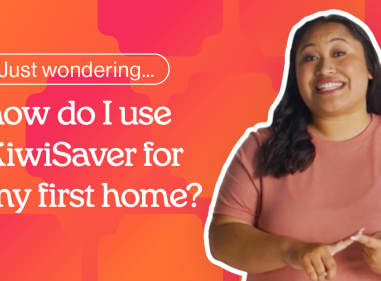
Planning & budgeting
Saving & investing
KiwiSaver
Tackling debt
Protecting wealth
Retirement
Home buying
Life events
Setting goals
Money tracking
Plan your spending with a budget
Getting advice
Studying
Get better with money
What pūtea beliefs do you have?
How to build up your emergency savings to cover unexpected costs
How to save your money
How to start investing
Find a financial adviser to help you invest
Your investment profile
Compound interest
Net worth
Types of investments
Term deposits
Bonds
Investment funds
Shares
Property investment
How KiwiSaver works and why it's worth joining
How to pick the right KiwiSaver fund
Make the most of KiwiSaver and grow your balance
How KiwiSaver can help you get into your first home
Applying for a KiwiSaver hardship withdrawal
How to use buy now pay later
What you really need to know before you use credit
How to get out of debt quickly
Credit reports
Know your rights
Pros and cons of debt consolidation
Credit cards
Car loans
Personal loans
Hire purchase
Student loans
Getting a fine
What happens if I start to struggle with moni?
How to protect yourself from fraud and being scammed
About insurance
Insurance types
Insuring ourselves
Wills
Enduring powers of attorney
Family trusts
Insuring our homes
Losing a partner
Redundancy
Serious diagnosis
How to cope with the aftermath of fraud
Separation
About NZ Super – how much is it?
When you’re thinking of living in a retirement village
How to plan, save and invest for retirement
Manage your money in retirement
Find housing options in retirement
Four approaches to spending in retirement
Planning & budgeting
Saving & investing
How to build up your emergency savings to cover unexpected costs
How to save your money
How to start investing
Find a financial adviser to help you invest
Your investment profile
Compound interest
Net worth
Types of investments
Term deposits
Bonds
Investment funds
Shares
Property investment
View all
KiwiSaver
Tackling debt
How to use buy now pay later
What you really need to know before you use credit
How to get out of debt quickly
Credit reports
Know your rights
Pros and cons of debt consolidation
Credit cards
Car loans
Personal loans
Hire purchase
Student loans
Getting a fine
What happens if I start to struggle with moni?
View all
Protecting wealth
Retirement
Home buying
Reading time: 9 minutes

Refinancing (also called remortgaging) is a normal part of home ownership. It’s when you replace your mortgage with another in order to get better terms or borrow more.
It’s also a great opportunity to save thousands on interest and finish paying off your home more quickly. But how do you make the move to a better mortgage?
You may have seen or heard about mortgage interest rates that are lower than what you currently have. If you enter your loan details into our mortgage calculator you can see how much interest you’ll pay over the whole term. It’s easy to see that a lower interest rate could be a big help – so you’ll want to take advantage if you can.
However, refinancing your mortgage is not simply changing the interest rate on your existing loan. It’s actually repaying your current mortgage and taking out an entirely new one with different (hopefully better) terms. You either work with your existing lender or switch to a new one – whichever has the better deal.
Even when interest rates go down, your bank won’t automatically offer you the better deal. You need to shop around to see what’s available and go after it. Sites like interest.co.nz and moneyhub.co.nz show rates from different lenders across New Zealand.
By shopping around and getting a view on what’s available, you can make the best choices.
If you’re on a fixed rate mortgage and considering breaking your contract, you need to find out from your bank what they would charge you as a break fee. This is important as you need to compare this cost against the benefits of a new mortgage, to see if taking another deal is worth it. You can ask for your break fee to be emailed to you so you have it in writing.
With refinancing, you want to make sure you fully understand all the costs involved. These might include repaying any cash incentives you may have received or paying exit or discharge fees.
Online calculators like Sorted’s mortgage calculator can help you figure out what you’d save by switching to a lower interest rate. You can also see how much quicker you could pay off your loan if you keep the same repayments or increase them while at the lower rate. You could trim years off your mortgage!
For example, a $400,000 loan at 4% takes 20 years to pay off with a monthly repayment of $2,424. Switching to a rate of 3% but keeping the same repayments would reduce the term to but your mortgage is 3%, that would mean it takes 18 years and cost $65,300 less in interest.
But remember: Interest rates are not forever. They will likely change again in the next few years, perhaps back up again, which may mean the savings you make through refinancing does not outweigh the fees after all. It’s difficult to tell what the future may bring, so make sure it’s really worth it.
Your bank can help you determine whether refinancing is right for you by showing you the numbers. But if you’re not sure about staying with your lender, check in with a mortgage broker or two. They can shop around for you and help you find the right loan for your needs.
Many banks offer incentives for you to take out a loan with them, but there are typically costs that come with switching lenders, including solicitor fees to get the mortgage changed, new valuations and application fees.
Doing your homework will help you understand the overall costs vs the benefits.
When you apply to refinance, you’ll need to answer basic mortgage application questions and provide proof of your income, assets and employment to show you can afford the new loan. If you switch lenders, there may be further checks, such as a property valuation. This can take some time and add extra costs.
Mortgages are typically set up with a monthly repayment amount. But work out if you can pay half of this each fortnight instead. Why? Because there are 26 fortnights a year and not 24, you will end up making an extra month of repayments each year and take down your mortgage more quickly and cheaply.
“Remortgaging” or “refinancing” is when you replace your current mortgage with a new one with different (hopefully better) terms. You can work with your current lender or bank, or you can switch your loan to another lender if they have a better deal for you.
Refinancing is often part and parcel of owning a home. It can be an opportunity to pay less in interest and finish off your mortgage more quickly. For many it’s about financing their lifestyle or consolidating debt, too.
In addition to saving on interest, there are many reasons you might be looking to refinance:In addition to saving on interest, there are many reasons you might be looking to refinance:
If you’re reading this and interest rates have been falling, you could grab a much better deal if you refinance. Your bank won’t automatically offer you the better deal – you need to shop around on sites like interest.co.nz and moneyhub.co.nz and then take the initiative to refinance.
This will depend on how the terms on your current mortgage compare with your refinanced loan. To get an idea, fire up our mortgage calculator and plug in the interest rate and the length of the loan.
Saving $200 may not sound that significant when compared with a mortgage worth hundreds of thousands. But $200 every month over many months, could definitely be worth it. Take into account how long you expect to hold the mortgage.
More importantly, if you refinance and keep your current repayments as they are, how much could you save in interest? That will be worth much more, so enter your details into our mortgage calculator to get a view.
The key when deciding whether to refinance is to determine whether it is worth it. The only way to see that is by including all the costs involved and comparing them with the benefits you’re getting.
Only your current lender is able to show you the exact figures. If you are on a fixed rate mortgage and considering breaking your contract, ask your bank to email your break fee.
It’s important to take account of all the costs involved, and there can be additional fees when switching to a new bank as well. These costs include:
Lenders will check your credit history when you apply to refinance, so it’s good to know your credit score and see a recent report. Find out about who holds your credit details and how to get a free copy of your credit report.
When you apply too often for a mortgage or credit in general, it can drive down your credit rating. When you are shopping around for the best rate to refinance, different lenders will run your credit history.
So how to keep this from affecting your score? Do all your rate shopping within two or three weeks, so all your credit enquiries are treated as a single application instead of many.
Your credit history can also be affected negatively when you take out cash as part of a refinance arrangement.
Yes. Just as when you apply the first time for a mortgage, you apply and qualify for a remortgage. And you can be turned down.
Wrapping all your debts together and paying them off all at once by refinancing can be helpful. With a lower interest rate you can save a lot.
But it also depends how quickly you pay it off: if whacking it on the mortgage keeps it around for longer, it’s not as helpful or as cheap.
Debt consolidation can even lead to more debt if we’re not careful, such as when we end up with empty credit cards that can be run up all over again. The goal is to become debt-free, after all.
You’ve got a range of options available when you remake your mortgage, with various degrees of flexibility and different repayment structures. Find out more about the different mortgage options out there.
Guide
Getting into a first home takes careful planning and, for most of us, serious budgeting! These tips for first home…
Read more

Guide
The amount we can borrow for a home depends on a couple of things: how much we can afford to…
Read more

Guide
There are many types of mortgages, each with its own interest rate, fees and flexibility. Each of these things affect…
Read more

Guide
It can feel good being a home sweet homeowner! But – and there is “the but” – we still need…
Read more

Guide
A house is often the biggest purchase of our lives, and a mortgage (also called a home loan) is typically…
Read more

Video
KiwiSaver can help you save up a deposit for your first home. This free video tells what you need to…
Watch video

Use verification code from your authenticator app. How to use authenticator apps.
Code is invalid. Please try again
Don't have an account? Sign up
Or log in with our social media platforms


A free account gives you your very own space where you can save your tools and track your progress as you get ahead.
Or sign up using Google:


